

|

|
|||

|
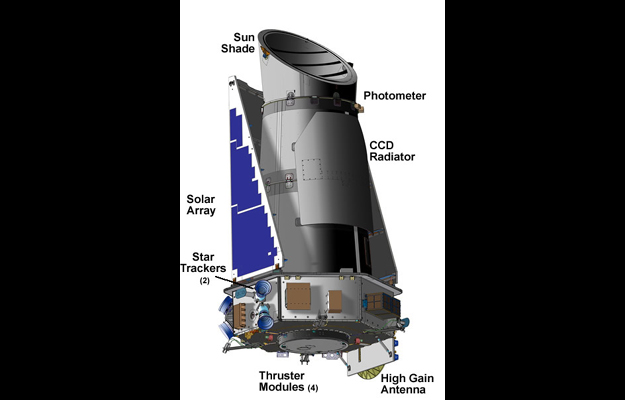
|
||
|
The Kepler Mission: NASA's first mission capable of finding Earth-size planets around other stars.
The centuries-old quest for other worlds like our Earth has been rejuvenated by the intense excitement and popular interest surrounding the discovery of hundreds of planets orbiting other stars. There is now clear evidence for substantial numbers of three types of exoplanets; gas giants, hot-super-Earths in short period orbits, and ice giants. The challenge now is to find terrestrial planets (i.e., those one half to twice the size of the Earth), especially those in the habitable zone of their stars where liquid water and possibly life might exist. The Kepler Mission, NASA Discovery mission #10, is specifically designed to survey a portion of our region of the Milky Way galaxy to discover dozens of Earth-size planets in or near the habitable zone and determine how many of the billions of stars in our galaxy have such planets. Results from this mission will allow us to place our solar system within the continuum of planetary systems in the Galaxy. Kepler is a space observatory launched by NASA to discover Earth-like planets orbiting other stars. The spacecraft, named after the Renaissance astronomer Johannes Kepler, was launched on March 7, 2009 As of January 2015, Kepler and its follow-up observations had found 1,013 confirmed exoplanets in about 440 stellar systems, along with a further 3,199 unconfirmed planet candidates. Four planets have been confirmed through Kepler?'?s K2 mission. In November 2013, astronomers reported, based on Kepler space mission data, that there could be as many as 40 billion Earth-sized planets orbiting in the habitable zones of Sun-like and red dwarf stars within the Milky Way. It is estimated that 11 billion of these planets may be orbiting Sun-like stars. The image is the Kepler Spacecraft and Photometer http://kepler.nasa.gov/Mission/QuickGuide/ http://en.wikipedia.org/wiki/Kepler_%28spacecraft%29 Send this link to anyone you think would be interested in reading this entry. |

|
|||

|
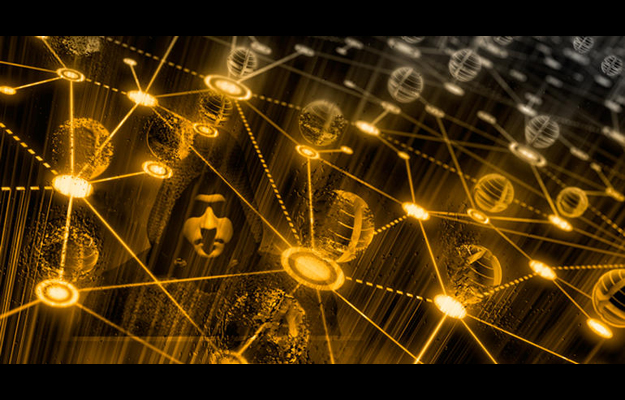
|
||
|
Diving into the Dark Web: Where does your stolen data go?
When a data breach occurs and personal information is stolen, where does it end up? Bitglass researchers decided to find out. Target, Morgan Stanley, Sony, Anthem - the list of today's major data breaches goes on. In the last few years alone, high-profile attacks have been launched against these companies and countless others, resulting in the theft of private communication, names, Social Security numbers, addresses, financial data and account credentials. According to a report released by the Identity Theft Resource Center (ITRC), in the United States alone in 2014, 783 data breaches were discovered. Since 2005, 5,029 data breaches have been reported in the US, with an estimated 675 million records stolen. The Dark Web is one place where stolen information is offered for sale. Accessible through the Tor network, the underground comprises of stores and websites entrenched in illegal activities ranging from the sale of data to hacking tools to drugs and weaponry. However, websites hosted on the network also offer free downloads of data, which is posted anonymously. The security team decided to track data offered up in the Dark Web. After creating a spreadsheet of 1,568 fake employee credentials, the team placed the file on anonymous file-sharing websites in the Dark Web, as well as Dropbox. The data was then tracked through Bitglass' tracking technology, which embedded the file with an invisible watermark that "pings" the Bitglass portal whenever the document is opened. After being pinged, the portal displays information including geographic location, IP address and device type. Bitglass found that within only a few days, the fake credentials had been downloaded in over five countries, three continents and was viewed over 200 times. By day 12, the file had received over 1,080 clicks and had spread to 22 countries on five continents. By the end of the experiment the fake document of employee data had made its way to North America, South America, Asia, Europe, and Africa. Countries frequently associated with cyber criminal activity, including Russia, China and Brazil, were the most common access points for the identity data. Security breaches are unavoidable. It can take months or even years for the enterprise to discover a security problem. By this point, stolen information may have already traveled worldwide. When so many data breaches are preventable, companies need to start investing more heavily not only in cybersecurity as a whole, but also begin tightening internal controls and data protection protocols to mitigate the risk of becoming a new victim in 2015. ~image and excerpt from: http://www.zdnet.com/article/diving-into-the-dark-web-where-does-your-stolen-data-go-in-the-underground/?tag=nl.e019&s_cid=e019&ttag=e019&ftag=TREd47db54 Resource: http://www.zebis.com/business.html Send this link to anyone you think would be interested in reading this entry. |

|
|||

|
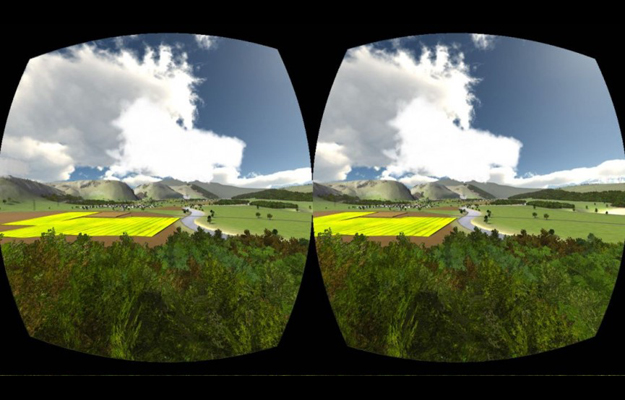
|
||
|
Virtual Reality Storytelling Is Taking Flight in 2015
Virtual Reality (VR) is a computer-simulated environment that can simulate physical presence in places in the real world or imagined worlds. Virtual reality can recreate sensory experiences, which include virtual taste, sight, smell, sound, and touch. Most current virtual reality environments are displayed either on a computer screen or with special stereoscopic displays, and some simulations include additional sensory information and emphasize real sound through speakers or headphones targeted towards VR users. Some advanced, haptic, systems now include tactile information, generally known as force feedback in medical, gaming and military applications. Furthermore, virtual reality covers remote communication environments which provide virtual presence of users with the concepts of telepresence and telexistence or a virtual artifact (VA) either through the use of standard input devices such as a keyboard and mouse, or through multimodal devices such as a wired glove or omnidirectional treadmills. The simulated environment can be similar to the real world in order to create a lifelike experience The promise of virtual reality has always been enormous. Put on these goggles, go nowhere, and be transported anywhere - throw off the shackles of the mundane through a metaphysical transportation to an altered state. Born of technology, virtual reality at its core is an organic experience. Yes, it's man meets machine, but what happens is strictly within the mind. It had crude beginnings. A definition of virtual reality has always been difficult to formulate - the concept of an alternative existence has been pawed at for centuries - but the closest modern ancestor came to life in the fifties, when a handful of visionaries saw the possibility for watching things on a screen that never ends, but the technology wasn't yet good enough to justify the idea. The promise of the idea was shrouded, concealed under clunky visuals. But the concept was worth pursuing, and others did (especially the military, who have used virtual reality technology for war simulation for years). The utopian ideals of a VR universe were revisited by a small crew of inventors in the late '80s and early '90s. Imagine 10 years ago trying to envision the way we use cellphones today. It's impossible. That's the promise VR has today. VR at its best shouldn't replace real life, just modify it, giving us access to so much just out of reach physically, economically. If you can dream it, VR can make it. It's a medium for progress, not the progress itself. Excerpts and image from: The Verge site is incredibly interesting, actually thrilling, full of the history of VR, where it is now, the companies involved and even how to build your own VR headset: http://www.theverge.com/a/virtual-reality/intro tp://en.wikipedia.org/wiki/Virtual_reality image: http://www.wareable.com/vr/vr-storytelling-reviews-sundance-film-festival Send this link to anyone you think would be interested in reading this entry. |

|
|||

|
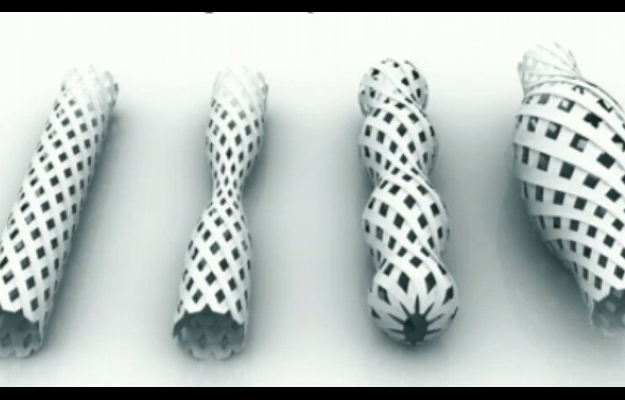
|
||
|
Forget the 3D Printer: 4D Printing Could Change Everything
Scientists at MIT are using a new technique that could print responsive objects from water pipes to sneakers that adapt to their surroundings on their own. At the Massachusetts Institute of Technology, researchers were trying to come up with a way of describing the objects they were creating on 3D printers - objects that not only could be printed, but thanks to geometric code, could also later change shape and transform on their own. The process they developed - which turns code into "smart objects" that can self-assemble or change shape when confronted with a change in its environment - could very well pop up in a number of industries, from construction to athletic wear. Normally, we print things and we think they're done. But we want them to be able to transform and change shape over time. And we want them to assemble themselves. ~excerpt and photo from: tp://www.smithsonianmag.com/innovation/Objects-That-Change-Shape-On-Their-Own-180951449/ Send this link to anyone you think would be interested in reading this entry. |

|
|||

|
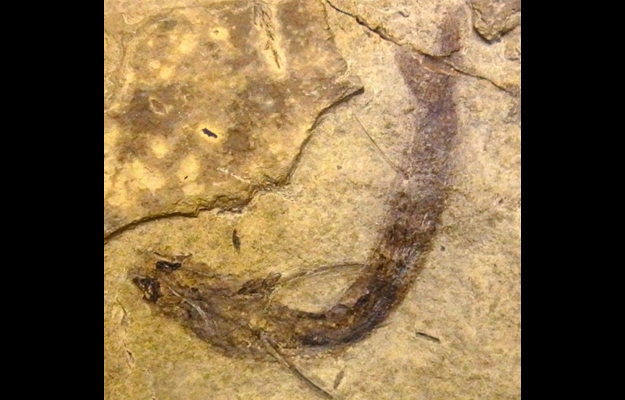
|
||
|
300 Million Year Old Fish Likely Had Color Vision
Scientists have discovered rod and cone cells while examining the fossil of 300-million-year-old fish eyes. The findings suggest that the fish likely possessed color vision. Scientists found the fossil of a fish that measured about 10 centimeters long. The fossil was found in Hamilton Quarry, near Hamilton in Kansas. Researchers suggest that Hamilton Quarry was a shallow lagoon in ancient times and fossils discovered from the area are usually well preserved as they got buried very swiftly in the sediments of the lagoon. Rods and cones are not usually preserved, because these soft tissues are more fragile. However, the fossil of the latest fish was so well-preserved that rod and cone cells are still visible in the eyeballs under an electron microscope. Scientists had long believed that modern eyes developed millions of years ago and the latest discovery provides a definitive proof. ~excerpt and photo from: http://www.techtimes.com/articles/22888/20141224/scientists-discover-rods-and-cones-in-300-million-year-old-fish-eyes-what-findings-suggest.htm Send this link to anyone you think would be interested in reading this entry. |

|
|||

|
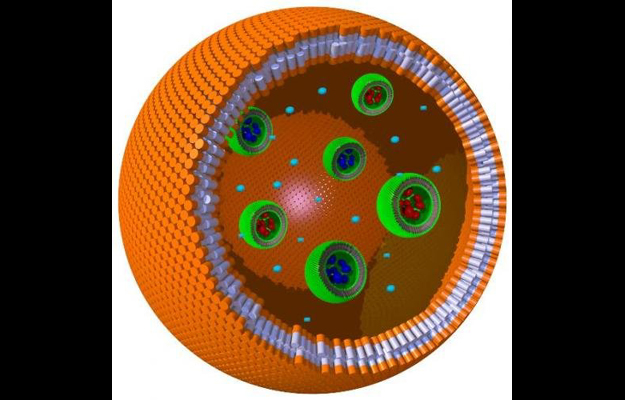
|
||
|
Plastic Cell
For something so tiny, a biological cell is a remarkably crowded place. In multi-celled creatures known as eukaryotes, each cell is packed with even smaller structures - organelles - that have specific functions, often related to controlling chemical reactions. To better understand cell chemistry, scientists at Radboud University Nijmegen in the Netherlands created the first artificial cell with actual working parts inside. They trapped tiny spheres filled with enzymes inside a water droplet and coated the whole thing with a polymer. The resulting "plastic cell" initiated a cascade reaction among the enzymes inside, essentially mimicking the way organelles function. ~excerpt and photo from: http://www.smithsonianmag.com/science-nature/ten-cool-science-stories-you-may-have-missed-2014-180953747/ |

|
|||

|
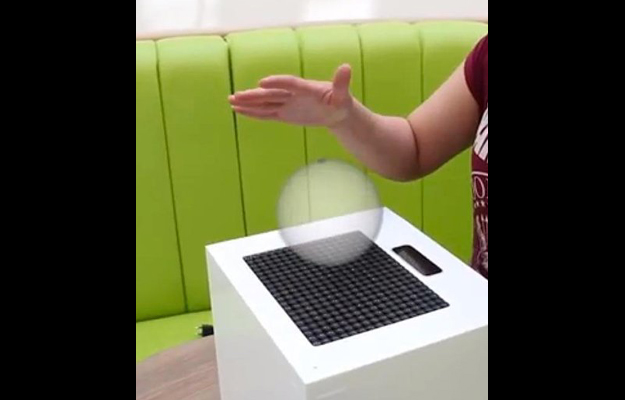
|
||
|
Feeling a Holograph
It's no night on the Holodeck, but technology unveiled in December can let you see and touch a virtual sphere for the first time. Researchers used an ultrasound device to focus disturbances in the air created by sound waves into 3D shapes. The floating shapes are visible to the naked eye and create haptic feedback when you touch them. The work is still in an early phase, but the researchers anticipate that more advanced devices could create touchable CT scans and interactive museum displays. ~excerpt and photo from: http://www.smithsonianmag.com/science-nature/ten-cool-science-stories-you-may-have-missed-2014-180953747/ |

|
|||

|
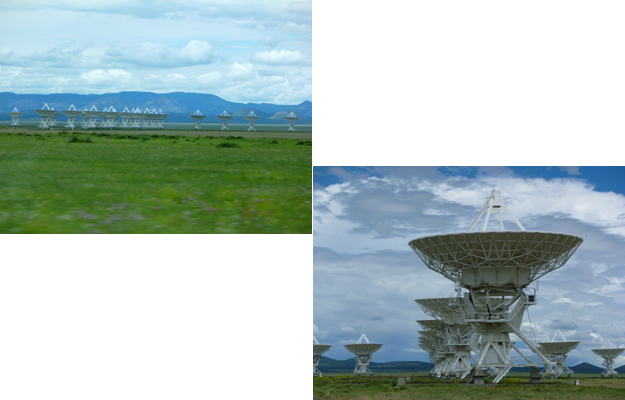
|
||
|
Very Large Array
The Karl G. Jansky Very Large Array (VLA) is a radio astronomy observatory located on the Plains of San Agustin in New Mexico. Astronomers using the VLA have made key observations of black holes and protoplanetary disks around young stars, discovered magnetic filaments and traced complex gas motions at the Milky Way's center, probed the Universe's cosmological parameters, and provided new knowledge about the physical mechanisms that produce radio emission. The observatory consists of 27 independent antennae, each of which has a dish diameter of 82 feet and weighs 209 metric tons. This is a very amazing place and if you are ever in the area you really need to spend time exploring the inside exhibit and walking the grounds. It is so impressive. There are 2 photos here so you can get an idea of the scope from afar and the size from close-up. ~ partial excerpt: http://www.vla.nrao.edu/ original photos by dmdart |

|
|||

|
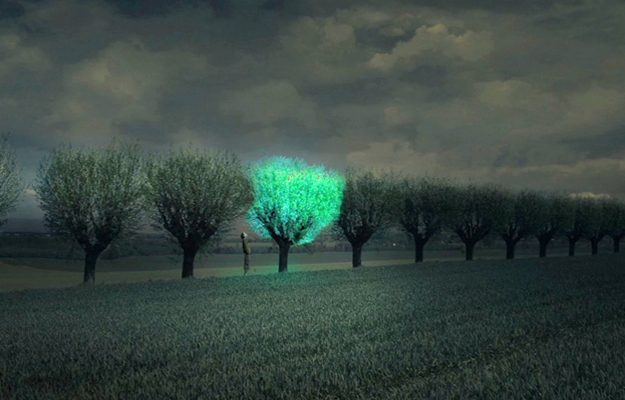
|
||
|
Merging Worlds of Nature and Technology
A laboratory at Stony Brook University, working with designer Dann Roosegaarde, has developed a glowing plant by merging luciferin-which is the chemical that enables fireflies to glow-with a simple plant. The result is a plant, in dirt, that glows. Naturally. And it is awesome. His concept is based on "merging worlds of nature and technology" by taking what we can learn from nature and applying that to the world through the building of technology-namely, the urban landscape. In fact, he says, this marriage of our super- and sans-natural environment will drive the perception of technology to "completely disappear" and humans will no longer rely exclusively on screens to gain information and utility. So while we humans use a massive amount of generated electricity to defeat darkness, Jellyfish create their own light deep underwater without solar panels, wind turbines, or hydroelectric dams. Instead, the organism generates power completely autonomously. The vision is realized by transforming a magnificent aspect of our human mechanical world where we can replace centuries-old, energy-guzzling street lamps with beautifully glowing trees. ~excerpt and image: http://blog.suny.edu/2014/03/future-cities-lit-by-beautiful-bioluminescent-trees/ |

|
|||

|
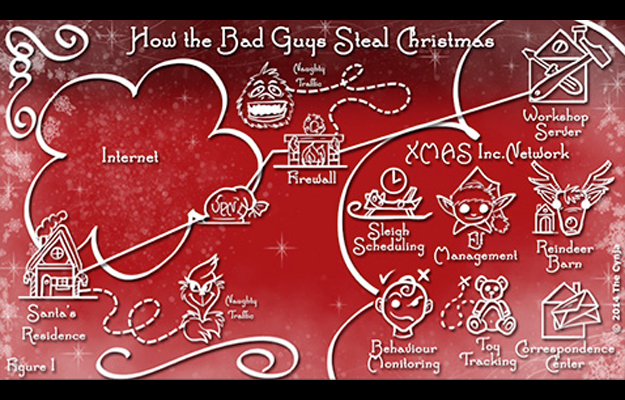
|
||
|
A Great Christmas Eve Article
I wrote a blog entry on 12/18 about The Cynja, which led me to more research into the people who have put that project together. Being that I am a founding partner at Zebis, a Solution Development firm, I am involved with Internet security as we deal with that issue for our clients everyday. My reading led me to an article, "More than reindeer games", that is written by one of The Cynja team members, Chase Cunningham. Because I'd like you to take the time to read the whole article, it's entertaining and addresses Internet security, I am including the first 2 paragraphs here, with the hope this will be an enticement: "Dear Santa, As CEO of XMAS Inc., the leading manufacturing and shipping enterprise, you face extraordinary pressure to deliver joy on Christmas morning to billions of kids around the world. In fact, it's hard to think of any other top business leader who is responsible for so many children's dreams each year-and whose executive compensation package consists entirely of cookies and milk. With only a single workshop located in a hostile climate, a limited number of legacy employees, one used vehicle, no financing and an extraordinary supply of sugar you've been able to accomplish more than what any of your competitors-all with far greater resources-will achieve over the course of their entire careers. But Santa, regardless of your unimpeachable track record, the news headlines we all hear-the ones about Sony, Staples, Target or the Home Depot compromise-are, sadly, all too real and devastating. These attacks demonstrate that believing in Christmas magic, sugar plum fairies or laying your finger aside of your nose are no longer an effective security strategy. You, of all people, know better than many corporate leaders, that the cyber naughty list is growing longer each year. The link for the article is: http://www.net-security.org/article.php?id=2190 This article is art. It catches the attention from a writing perspective, has an entertaining story-line, while delivering important thoughts about Internet security. Perfect combination. Keep your Internet interactions safe this holiday season and Happy Christmas Eve. |

|
|||

|
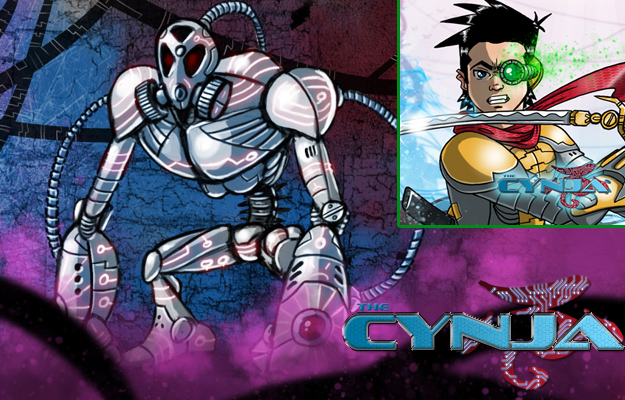
|
||
|
The Cynja
Since I work in the technology field, I am constantly researching what's out there. Personal and business security is a very major focus and we find we are fighting malware, mis-information and malicious attacks daily. It was amazing to me that "a recent survey showed that children are 51 times more likely to become targets of identity-stealing thieves." This was in a report published by Richard Power, Distinguished Fellow of the Carnegie Mellon CyLab. The report is compelling reading: https://www.cylab.cmu.edu/files/pdfs/reports/2011/child-identity-theft.pdf Then I stumbled upon an article in one of my technical journals and I was entranced with the idea of bringing our children in on the fight for Internet security. Three people have written, designed and illustrated a print and e-book for children that explains the wild cyber world of worms and zombies and Trojans and show how awesome this world really is. It also introduces an important life lesson: we now live in an era of digital crime. It's a cool story about cyberspace that grabs a kid's imagination, teaches them about being safe online, and possibly will inspire the next generation of security professionals. Visualization is a real challenge and the creators wanted to illustrate The Cynja in a way that would enable people to understand the gravity of being stuck in an infected network or encountering malicious malware. There is much more information at the web site of Cynja and I encourage you to go there and read about this amazing and timely book: thecynja.com Perhaps this will help teach children and adults alike to fight the cyber criminals who infest our digital lives. ~excerpts and graphics from TheCynja.com |

|
|||

|
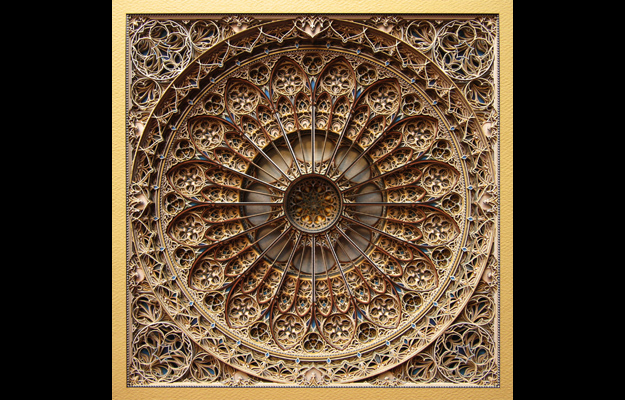
|
||
|
Cut
"Eric Standley draws his themes from Islamic and Gothic architecture and art, formed in the 12th century. The technique he follows for the "building" of his works does not differ from that of the ancient craftsman other than he uses lasers in the place of the chisel and hammer. Eric's work consists of successive layers of intricately cut paper sheets utilizing a laser, thus creating a multifaceted, rich, colorful ensemble. The result is so complex and detailed that the works should be examined from multiple perspectives to be fully appreciated. The bold determination to shift from the permanence and massiveness of stone and the material allure of glass to the instability and familiarity of paper is rewarded by the induced pleasure stimulated while gazing at the work. It is not the quality of the raw material that makes art, but the art that gives quality to the raw material." ~excerpt from artist's web site: read more about Mr. Standley's work at his web site: www.eric-standley.com Why is technology included in an Art|Centric blog? Because great technology is the direct result of great design. And design is art. |

|
|||

|
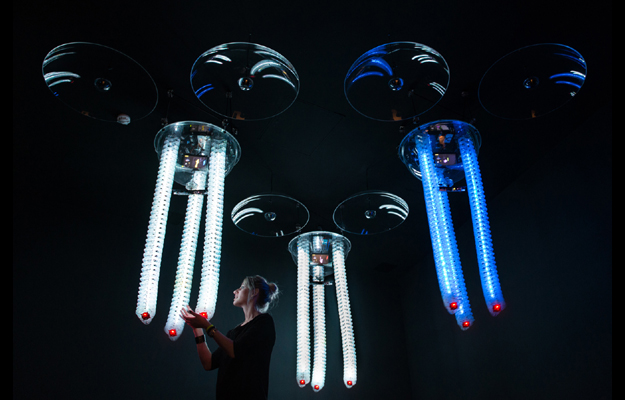
|
||
|
Petting Zoo FRAC Centre
At this petting zoo, instead of rubbing cute goats and furry rabbits, you get to get close to snake-like tubes hanging from the ceiling. These are very responsive tubes, bending and moving and changing colors based on how they read your movements, sounds and touch. They might pull back shyly if they sense a large group approaching or get all cuddly if you're being affectionate. And if you're just standing there, they may act bored. From the web site: Petting Zoo is the latest work developed by experimental architecture and design studio Minimaforms. The project is a speculative life-like robotic environment that raises questions of how future environments could actively enable new forms of communication with the everyday. Artificial intelligent creatures have been designed with the capacity to learn and explore behaviors through interaction with participants. Within this immersive installation interaction, the pets foster human curiosity, play, forging intimate exchanges that are emotive and evolving over time. Beyond technology the project explores new forms of enabled communication between people and their environment. The installation exhibits life-like attributes through forms of conversational interaction establishing communication with users that is emotive and sensorial. Conceived as an immersive installation environment, social and synthetic forms of systemic interactions allow the pets to engage and evolve their behaviors over time. Pets interact and stimulate participation with users through the use of animate behaviors communicated through kinesis, sound and illumination. These behaviors evolve over time through interaction enabling each pet to develop personalities. Pet interactions are stimulated through interaction with human users or between other pets within the population. Intimacy and curiosity are explored as enabling agents that externalize personal experience through forms of direct visual, haptic and aural communication. -excerpt from the web site: minimaforms.com |

|
|||

|
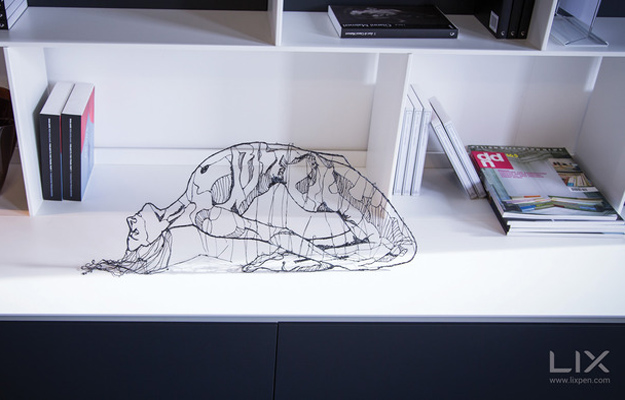
|
||
|
3D Printing Pen
This is incredible! This kickstarter campaign met it's goal in the Spring. This 3D pen enables you to doodle in the air without using paper. (Can you imagine!) This is creativity on a whole new level. The 3D printing pen has the similar function as 3D printers. It melts and cools colored plastic, letting you create rigid and freestanding structures. It has a hot-end nozzle that is power supplied from wall charger. The plastic filament is introduced in the upper extremity of Lix Pen. The filament goes through a mechanism while moving through the pen to finally reach the hot-end nozzle which melts and cools it down. Structures can be formed in any imaginable shape. There is much more information on the Internet. I thought you might enjoy more art of technology. * Why is technology included in an Art|Centric blog? Because great technology is the direct result of great design. And design is art. |

|
|||

|

|
||
|
3D printers
"Star Trek" promised replicators that could print out anything in seconds, even a cup of "Earl Grey, hot." While the technology isn't there yet, it is getting closer, thanks to 3D printers. These devices convert a digital design into any small, plastic 3D object that your imagination and design skills (or designs you download) can come up with, from a tchotchke to a replacement part for a device to a prototype. The appeals are obvious: Manufacture anything you want out of plastic, right on your desktop. There's no cause to go to the store to buy something that was made in China, put on a boat, loaded onto a truck, and placed on a shelf. 3D printers can make nearly any object you can dream up by laying down small layers of plastic on top of each other. People around the world use them to make everything from artwork to practical everyday items. 3D print a fork. 3D print a whistle. You're limited only by your imagination, and you can get started by printing innumerable things people have already designed and uploaded for experimantation. -excerpts from on-line resources * Why is technology included in an Art|Centric blog? Because great technology is the direct result of great design. And design is art. |
|
|
|
home |
photography |
3d art |
technology |
diverse |
archive |
comments |
dmdart.com |
zebis.com |
sitemap |
contact me by e-mail
|
| © 2014 dmdart.com/blog : a very small division of Zebis, Inc. - All rights reserved. |